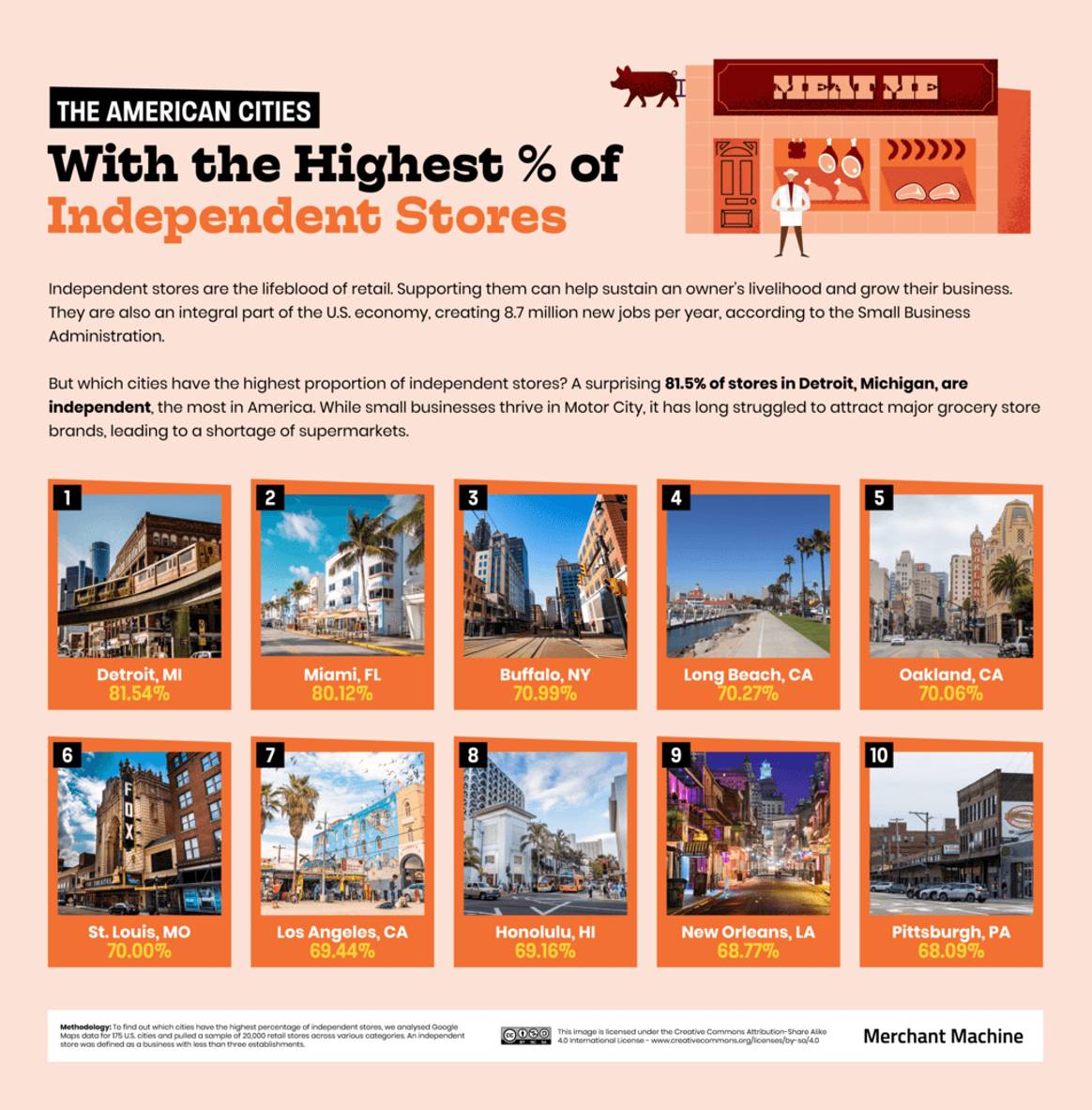Engaged in the clothing industry for 20 years.

Top US cities paving the way for independent retailers
When shopping for a new shirt, pair of jeans, or dress, chances are you’re likely to head to a big-box retailer, department store, or chain store to find what you’re looking for. While apparel remains an essential part of our daily lives, many overlook local independent retailers when making their next clothing purchase. Yet, independent retailers remain a fundamental part of the US commercial economy.
According to the US Chambers of Commerce, there are 33.2 million small businesses across the nation, which together account for 99.9 percent of all American registered companies. What’s more, small businesses were responsible for nearly two-thirds (63 percent) of new job creation, amounting to 17.3 million jobs between 1995 and 2021, based on data from the US Small Business Association (SBA).
Representing 97.3 percent of all exporters and contributing 32.6 percent (413.3 billion USD) to export value, small businesses employ almost half (46 percent) of the private sector workforce and account for 43.5 percent of the nation’s GDP. Business is booming in the US—at least in terms of entrepreneurship.
Over the past few years, application numbers to open new businesses have witnessed an upswing, with 2023 seeing a record-breaking 5.5 million new applications filed, according to the US Census Bureau. 978,400,000 of these applications were within the retail trade, as the global pandemic led to economic shifts and new consumer behaviors, fostering an environment ripe for new business ventures. With many consumers turning their ideas, side hustles, and hobbies into small businesses, this has only seen more and more independent retailers set up shop.
The US states with the highest percentage of indie retailers
While retail giants keep a strong grip within the US retail landscape, with Walmart making a whopping 499.65 billion USD in US retail sales in 2023 alone, according to research from the National Retail Federation, independent retailers hold significant value. Not only do they support the funding of public services, but indie retailers also sustain individual livelihoods and passions. According to the American Independent Business Alliance, nearly 48 percent of every dollar spent at local businesses is reinvested into the local economy, compared to just 13 percent for major chains. Supporting local communities, more than 9.3 billion USD would be directly returned to the US economy if every family spent 10 USD a month at local independent retailers, according to data from the Business Journal.
As Independent Retailer Month 2024 kicks off across the nation, we look at data compiled by Merchant Machine that analyzed the distribution of over 20,000 independent and chain stores throughout the US to determine which cities have the highest concentration of independent retailers.

Where in America are independent retailers flourishing? Although some may think of Southern states like Texas or Eastern states like Chicago or New York City, or even California in the west, it is actually the state of Michigan that leads the way, with nearly three-quarters (73.5 percent) of its retail stores being independent small businesses. Reflecting a strong preference for ‘mom-and-pop’ stores, the state’s governor, Gretchen Whitmer, is a leading advocate for small businesses and fully endorses the ‘Support Local’ campaign to encourage consumers to shop independent retailers within Michigan. A 2022 study carried out by the Michigan Retailers Association found that diverting just 10 percent of consumer spending from major out-of-state businesses to local stores would generate 16,000 new jobs and inject 1.2 billion USD into Michigan’s economy, making it a win-win situation for all involved.
The city of Detroit reflects Michigan’s strong support for independent retail, with a stunning 81.54 percent of its stores being independently owned – the highest percentage among US cities research. Historically, Detroit has faced several challenges in attracting large chain stores, which dates back to its decline in the 1940s, triggered by job losses in the auto industry, rapid suburbanization, and other factors. This apparent gap in the market has led to more opportunities for local retailers and businesses, as well as city-wide inflation on everyday items, increasing the burden on family-owned retailers, like grocers in particular. COVID-19 further exacerbated issues faced by Detroit’s independent retailers, as key employers like Ford and General Motors closed their offices, reducing customer traffic. Nevertheless, the Detroit Chamber of Commerce remains hopeful that 2024 will see a resurgence in foot traffic, revitalizing the city’s independent retail sector.
Coming in second, Miami, in Florida, is another leading city with a booming and vibrant independent retail sector, where 80.12 percent of its stores are small businesses. Part of a wider increase in local entrepreneurship, Florida saw a record-breaking 667,031 new business applications in 2023, ranking in third place of the US 2023 business applications per capita. Additionally, businesses in Miami-Dade County increased by 27 percent in 2021 and saw the most business applications in 2023. Miami remains one of four major metropolitan areas where demand for retail space grew in 2022, with its iconic South Beach and Coral Gables districts serving as hubs for artisan retailers.
The state of Hawaii is home to the second-highest proportion of independent retailers in the US, according to the study, with 69.1 percent of its stores owned by small businesses. However, Aloha State remains one of the most challenging environments for small businesses to thrive in due to the state having the highest tax burden in the country. The devastation to Lahaina following the outbreak of wildfire has further added to the post-pandemic decline in tourism, which is crucial to Hawaii’s economic health. In response to disruptions caused by COVID-19, Oahu’s Chamber of Commerce launched a 10 million USD grant program to support the island’s small businesses, while the Maui Small Business Recovery Grant Program provided 5,000 USD grants and business coaching to 100 small businesses affected by the wildfires in August 2023.
Among the 20 largest cities in the United States, Los Angeles, California, had the highest proportion of independent stores, at 69.4 percent, followed by San Francisco, with 67.9 percent of its retail businesses being owned independently.
With 94 percent of consumers stating that shopping at small, local businesses makes them feel good, according to research from the National Federation of Independent Business and American Express, the potential for independent retailers to survive and thrive seems to be on the rise once more.



